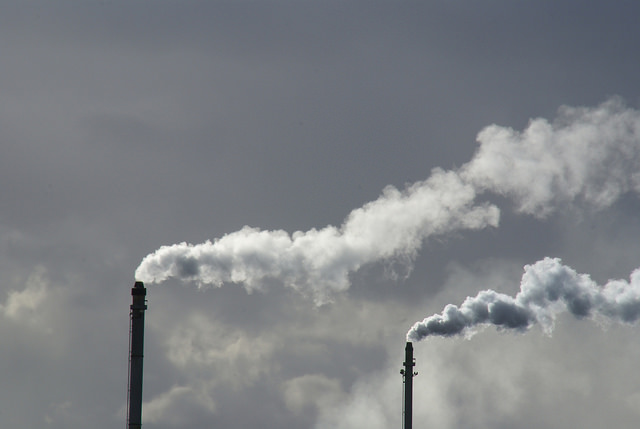Is The U.S. Underestimating Methane Emissions From Animal Ag?
Greenhouse gas emissions from the farming of non-human animals are a major contributor to climate change. This is especially true for “ruminants,” or animals who regurgitate and re-chew plant matter as part of their digestive processes, such as cows, pigs, and sheep. Thus, keeping track of methane emissions due to ruminant agriculture is an important part of counting the overall burden for climate change in many countries. Typically, countries count their methane emissions with complex mathematical models that estimate how much methane they’re putting into the atmosphere. This approach is known as “bottom-up modeling.” However, another approach, called “top-down modeling” reverses this logic—instead, it uses direct measurements of methane in the atmosphere to estimate how much the areas below are producing.
Generally speaking, these two approaches “agree” with each other when focusing on global, overall emissions. When focusing on agriculture in the United States specifically, though, top-down models show anywhere from 39-90% more methane in the atmosphere than the bottom-up models predict. In a recent review of several studies, researchers from New York University and Johns Hopkins University explored why this dramatic difference between the two approaches might exist. Ultimately, they show that methane emissions from farmed animals in the United States are likely higher in reality than what is reported. This has important implications both now and in the future for the U.S. and developing countries modeling their own food systems after their western counterparts.
To provide some background on the current state of non-human animal farming operations, the authors first highlight how the bulk of this farming is done. Specifically, in developed countries, much of the farming is known as “intensive.” What that means is that the animals have extremely unnatural lives: they live to eat, are optimized in every way to yield the most meat or milk, and live much of their lives in the most minimally acceptable conditions. The technical term for this is “concentrated animal farming operations,” or CAFOs. While CAFOs use less overall energy and space than other types of farming operations at scale (such as open-field grazing), the welfare cost to the animals—both physically and psychologically—is extreme.
Given the emission and spatial concerns, developing countries are encouraged to move towards intensive farming despite the glaring issues of animal welfare. As noted above, however, methane emissions from intensive farming, may be fully 39-90% higher than official records in the U.S. show. Thus, the importance of better understanding methane emissions for the sake of climate change is clear, both for the developing and developed world. To add further urgency, global consumption of non-human animal products is expected to rise by nearly 50% by 2050.
For their eview, the authors looked at eight other studies that used top-down approaches to gather data on atmospheric methane. Given that bottom-up models rely on simplifying assumptions and do not directly measure methane in the atmosphere, the top-down models, which offer direct measurements of atmospheric methane, may be the superior approach, at least in some areas of study. At a global scale, they found that bottom-up models may only be off by 5%—an acceptable range given the margin of error in some studies. In the United States, however, as mentioned, this difference ranges from 39-90%.
The researchers report that it’s unclear why this difference is so large. Some potential reasons include that bottom-up models underestimate methane emissions from manure and that U.S. farms have more animals with diseases and infections. Also alarming: bottom-up models predict that methane emissions due to agriculture will be much lower by 2050 than the predictions from top-down approaches. Given the disparity between the two today, bottom-up models may paint an overly optimistic version of the future given current farming practices. As Hayek and Miller highlight, there are major limits to the intensification of agriculture with respect to sustainable development. Public health and environmental concerns are major issues in this regard, including antibiotic resistance, ethical treatment of the animals, increased monoculture in the global food supply, and exacerbated risk of zoonotic infections and diseases (such as COVID-19), to name a few.
In closing, the review offers some recommendations for policies and future research. First, technological and biotechnological breakthroughs could help. Replacing some amount of cow feed with seaweed, for example, could substantially reduce general greenhouse gas emissions from cows’ digestive processes. Similarly, recycling manure as fertilizer and biofuel could further limit the atmospheric impact of the cows’ lifecycle. Second, reframing the debate in terms of social equity and animal welfare would encourage fewer, but better-treated non-human animals to be farmed. Direct and indirect emissions could be reduced in this way, while also improving the quality of life of the animals themselves. Third, and related to the second point, reducing or eliminating the consumption of non-human animals would dramatically curb the impact of agriculture on climate change. Reforming dietary guidelines away from individual health alone and towards long-term health both for existing and yet-to-be-born populations would reorient quality of life to include considerations for the future. Finally, incentivizing farmers to not rely so heavily on such environmentally intensive products presents a supply-side lever to pull towards this end.
On the whole, this study highlights the need to approach climate change from multiple angles. While top-down models are incredibly useful, they have flaws of their own, such as being overly reliant on wind measurements. A longer-term strategy of combatting climate change will include scientific progress, technological innovations, and moral breakthroughs as well. Each of them has a role to play in preserving the environment, both today, and 100+ years from now.
https://doi.org/10.1088/1748-9326/ac02ef

















